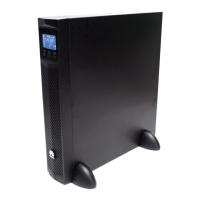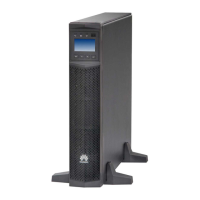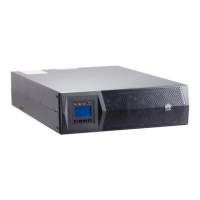Number of Battery
Strings
Number of Cells
in a String
40 Ah/12 V 40 batteries
in series
connected in parallel
40 x 6 = 240 40 Ah + 40 Ah + 40
Ah = 120 Ah
100 Ah/12 V 32 batteries
in series
Two battery strings
connected in parallel
32 x 6 = 192 100 Ah + 100 Ah =
200 Ah
1. After the LCD starts properly, perform the following operations:
• If the UPS is starting for the first time, set the language, date and time, network parameters,
and system parameters on the Settings Wizard screen.
• If this is not the first startup, retain the previous settings.
Various languages are available, such as Chinese and English.
Select the date format and so on.
IP address allocation, IP address, Subnet mask, and Gateway.
Single (default value) or Parallel.
Set the voltage level, output frequency, battery capacity, and the number
of batteries.
2. If no exception alarm is reported on the monitoring page after you specify settings on the
Settings Wizard screen, perform subsequent steps. If exception alarms are reported on the
monitoring page, clear all the alarms.
3. Check that the bypass input is normal and the system has transferred to bypass mode. You can
confirm this by viewing the system running diagram on the LCD.
4. Start the inverter.
• On the main screen, tap Common Functions. Tap Inv. ON.
• If you have not logged in, enter a user name and password, and tap on the login screen
displayed.
Set IP address allocation to Automatic. IP address, Subnet mask, and Gateway do not need
to be set. They are automatically assigned by the ECC.
You need to change the LCD password and Web password respectively to ensure access security.
5. In the displayed dialog box, tap Yes to start the inverter.
6. Ensure that the UPS transfers to normal mode. View the system running diagram to check that
the Bypass mode alarm disappears on the LCD. Check the UPS three-phase output voltage
and frequency by viewing the AC Output on the LCD. Use a multimeter to measure the three-
phase output voltage and frequency. The three-phase output voltage should be 208 V, 220 V,
or 230 V, and the frequency should be 50 Hz or 60 Hz.
7. Check that the actual battery capacity and number of cells are consistent with the settings on
the LCD. (A cell is a 2 V battery. For 12 V batteries, the number of cells equals the number of
batteries multiplied by 6. For 2 V batteries, the number of cells equals the number of batteries.)
Use a multimeter to check that the sum of the absolute voltage of the negative battery string
and the voltage of the positive battery string is greater than a certain value (2 x Number of cells)
to ensure that the battery strings are connected properly.
8. After checking that the battery strings are properly connected, close the battery circuit breaker
(if there are multiple battery strings, close the circuit breaker for each battery string and then the
general circuit breaker between battery strings and the UPS).

